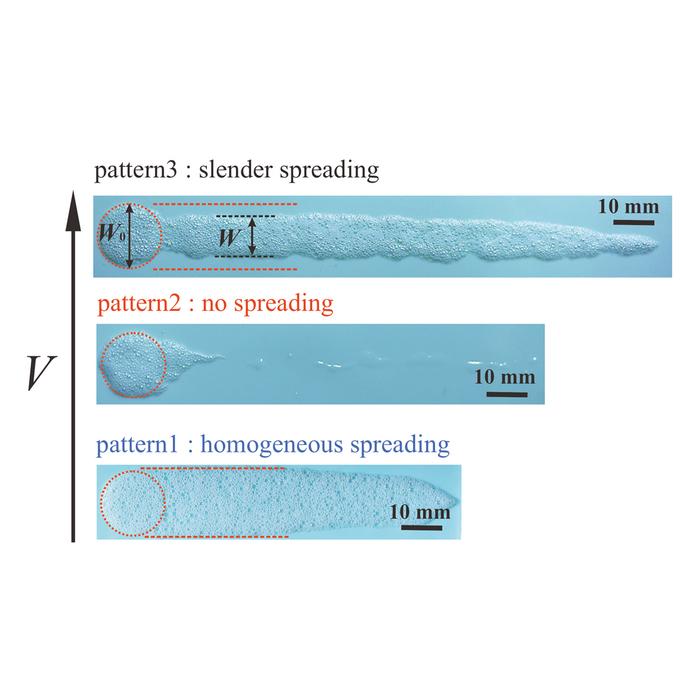Tokyo, Japan – Researchers from Tokyo Metropolitan University have uncovered the physics behind how foams are spread on surfaces. Balls of foam placed on a flat substrate were scraped across with a plate and observed. They identified different patterns which strongly depend on the scraping speed, governed by competing physical phenomena. Their findings apply to all kinds of soft materials that need to be spread evenly on surfaces, from mayonnaise on bread to insulation on walls.

Credit: Tokyo Metropolitan University
Tokyo, Japan – Researchers from Tokyo Metropolitan University have uncovered the physics behind how foams are spread on surfaces. Balls of foam placed on a flat substrate were scraped across with a plate and observed. They identified different patterns which strongly depend on the scraping speed, governed by competing physical phenomena. Their findings apply to all kinds of soft materials that need to be spread evenly on surfaces, from mayonnaise on bread to insulation on walls.
Whether it be shaving foam, insulating foam in walls, or margarine on toast, the spreading of soft materials on flat surfaces is an important process, both from a practical, everyday point of view and the optimization of industrial processes. Yet surprisingly little is known about the spreading behavior of foams, particularly when it comes to how a flat blade or plate can scrape it across the surface into a layer.
This inspired researchers led by Professor Rei Kurita from Tokyo Metropolitan University to take a closer look at what’s going on. They created small domes of detergent foam on a flat surface and scraped them across with an acrylic plate, taking care to keep the distance between the plate and the surface fixed. The whole process was observed in depth with a video camera. Curiously, they discovered that the way in which the foam spreads changes completely when the speed of the plate is varied, and how much affinity the liquid in the foam has for the surface, i.e., whether it’s hydrophilic (attracts water) or hydrophobic (repels water).
On a hydrophobic surface, at low scraping speeds, the foam spreads evenly, creating a long section with the same width as the original dome. However, as the velocity is ramped up, the foam no longer spreads but coasts along the surface on a thin layer of fluid; the plate moves along leaving very little foam in its wake. Finally, at the highest speeds they tried, the spreading regime comes back, only now, the width of the tail of foam is thinner than the original dome. On the other hand, on a hydrophilic surface, there was no trace of the first regime.
The difference seen between the two surfaces led the team to focus on the effect of “wetting” i.e. whether the liquid in the foam likes to cover the surface. Focusing on the appearance of the low-speed regime, they found that on hydrophobic surfaces, films of detergent that make up the foam tend to anchor onto the surface since the liquid tends to “dewet”. The picture that emerges is one where the foam is simply progressively spread from the dome by the plate as it moves. However, if the foam is forced across fast enough to wet the surface, the foam now has a lubricating layer at the base. Walls in the foam, also known as Plateau borders, can no longer grab the substrate and lock itself into place. This is why a faster plate will leave a thin section of foam where the dome originally was, but push the rest across on a thin layer of liquid, leaving nothing but a trail of liquid. The investigation probed not only the plate speed, but also the effect of the gap width and how thick the plate is.
The team’s findings shed light on the lesser-known parts of an everyday phenomenon, with significant potential impact on not only foams, but a wider range of soft materials, whether it be paint, protective coatings, or mayonnaise.
This work was supported by JSPS KAKENHI Grant Numbers 20K14431, 17H02945 and 20H01874.
Journal
Journal of Colloid and Interface Science
DOI
10.1016/j.jcis.2023.07.023
Article Title
Scraping of foam on a substrate
Article Publication Date
13-Jul-2023




